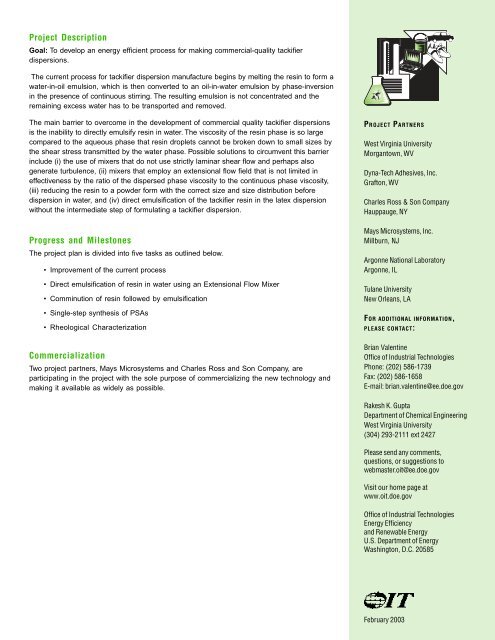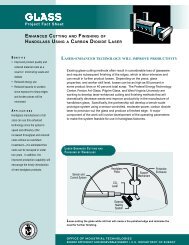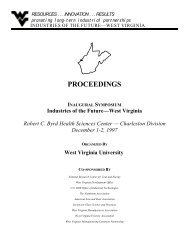tackifier dispersions to make pressure sensitive adhesives
tackifier dispersions to make pressure sensitive adhesives
tackifier dispersions to make pressure sensitive adhesives
Create successful ePaper yourself
Turn your PDF publications into a flip-book with our unique Google optimized e-Paper software.
Project DescriptionGoal: To develop an energy efficient process for making commercial-quality <strong>tackifier</strong><strong>dispersions</strong>.The current process for <strong>tackifier</strong> dispersion manufacture begins by melting the resin <strong>to</strong> form awater-in-oil emulsion, which is then converted <strong>to</strong> an oil-in-water emulsion by phase-inversionin the presence of continuous stirring. The resulting emulsion is not concentrated and theremaining excess water has <strong>to</strong> be transported and removed.The main barrier <strong>to</strong> overcome in the development of commercial quality <strong>tackifier</strong> <strong>dispersions</strong>is the inability <strong>to</strong> directly emulsify resin in water. The viscosity of the resin phase is so largecompared <strong>to</strong> the aqueous phase that resin droplets cannot be broken down <strong>to</strong> small sizes bythe shear stress transmitted by the water phase. Possible solutions <strong>to</strong> circumvent this barrierinclude (i) the use of mixers that do not use strictly laminar shear flow and perhaps alsogenerate turbulence, (ii) mixers that employ an extensional flow field that is not limited ineffectiveness by the ratio of the dispersed phase viscosity <strong>to</strong> the continuous phase viscosity,(iii) reducing the resin <strong>to</strong> a powder form with the correct size and size distribution beforedispersion in water, and (iv) direct emulsification of the <strong>tackifier</strong> resin in the latex dispersionwithout the intermediate step of formulating a <strong>tackifier</strong> dispersion.Progress and Miles<strong>to</strong>nesThe project plan is divided in<strong>to</strong> five tasks as outlined below.• Improvement of the current process• Direct emulsification of resin in water using an Extensional Flow Mixer• Comminution of resin followed by emulsification• Single-step synthesis of PSAs• Rheological CharacterizationCommercializationTwo project partners, Mays Microsystems and Charles Ross and Son Company, areparticipating in the project with the sole purpose of commercializing the new technology andmaking it available as widely as possible.PROJECT PARTNERSWest Virginia UniversityMorgan<strong>to</strong>wn, WVDyna-Tech Adhesives, Inc.Graf<strong>to</strong>n, WVCharles Ross & Son CompanyHauppauge, NYMays Microsystems, Inc.Millburn, NJArgonne National Labora<strong>to</strong>ryArgonne, ILTulane UniversityNew Orleans, LAFOR ADDITIONAL INFORMATION,PLEASE CONTACT:Brian ValentineOffice of Industrial TechnologiesPhone: (202) 586-1739Fax: (202) 586-1658E-mail: brian.valentine@ee.doe.govRakesh K. GuptaDepartment of Chemical EngineeringWest Virginia University(304) 293-2111 ext 2427Please send any comments,questions, or suggestions <strong>to</strong>webmaster.oit@ee.doe.govVisit our home page atwww.oit.doe.govOffice of Industrial TechnologiesEnergy Efficiencyand Renewable EnergyU.S. Department of EnergyWashing<strong>to</strong>n, D.C. 20585February 2003






